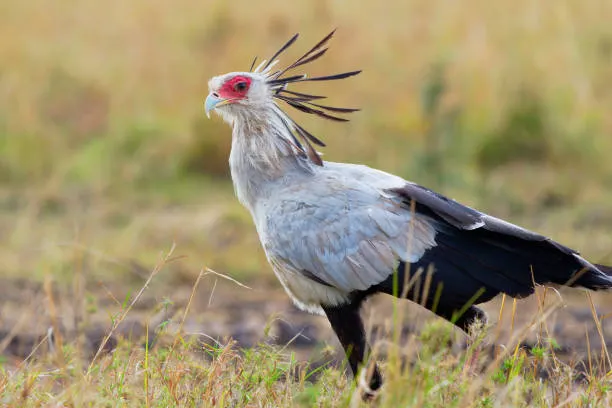About Secretary Birds

Striding across the African savannas with crane-like legs and a raptor’s beak, the secretary bird (Sagittarius serpentarius) is one of the most distinctive and awe-inspiring birds of prey on Earth. Known for their snake-stomping skills, dramatic appearance, and terrestrial lifestyle, these birds blend the elegance of a crane with the predatory power of an eagle.
Here’s everything you need to know about this fascinating bird.
General Overview
- Scientific Name: Sagittarius serpentarius
- Family: Accipitridae (same family as hawks and eagles)
- Habitat: Open grasslands, savannas, and scrub in sub-Saharan Africa
- Status: Vulnerable (IUCN Red List)
Physical Characteristics
- Unmistakable Appearance
Secretary birds stand about 4 feet tall (1.2 meters) with a wingspan of up to 7 feet (2.1 meters). They have long, stilt-like legs, a hooked eagle-like beak, and striking black quill-like feathers behind their head. - Elegant Yet Deadly
Their long legs aren’t just for show—they’re built for speed, endurance, and most importantly, delivering rapid, crushing kicks to prey, especially snakes. - Name Origins
The bird’s name is thought to have two origins:- Colonial Era Theory: The black feathers behind their head resemble 18th-century secretaries who tucked quill pens behind their ears.
- Arabic Origin Theory: Derived from “saqr-et-tair” (Arabic for “hunter bird”).

Behavior & Lifestyle
- Diurnal and Terrestrial Hunters
Unlike most birds of prey, secretary birds hunt on foot and rarely fly unless alarmed or returning to their nests. They walk up to 20 miles a day in search of food. - Deadly Snake Fighters
Their claim to fame: killing venomous snakes, such as cobras, puff adders, and mambas. They do this by stomping with incredible precision, often stunning or killing prey with a single blow. - Broad Diet
While they’re famous for eating snakes, they also consume:- Rodents
- Lizards
- Small birds
- Insects
- Amphibians
- Tortoises
- Stomping Power
Studies show their kicks can deliver five times their own body weight in force, with rapid-fire accuracy.
Nesting & Reproduction
- Monogamous and Territorial
Secretary birds typically form lifelong pairs and defend vast hunting territories together. - Nesting in Acacia Trees
They build large nests high in thorny trees to avoid predators. Nests can measure up to 8 feet wide after several years of use and rebuilding. - Chick Development
Females lay 1 to 3 eggs, and chicks are cared for by both parents. Chicks fledge in 65–105 days, remaining dependent for weeks afterward.
Ecological Role
- Pest Control Agents
By feeding on rodents and reptiles, secretary birds play an important role in controlling pest populations and keeping ecosystems balanced. - Symbol of Strength
The secretary bird is the national emblem of Sudan and features prominently on South Africa’s coat of arms, representing protection and vigilance.
Conservation Status
- Threatened by Habitat Loss
Though still widespread, secretary birds are considered Vulnerable due to:
- Habitat destruction
- Agricultural expansion
- Pesticide poisoning
- Human disturbance
- Protected in Many Reserves
Conservation areas in East and Southern Africa provide crucial sanctuaries for breeding and hunting.
Quick Facts Table
| Feature | Details |
|---|---|
| Height | ~4 feet (1.2 m) |
| Wingspan | Up to 7 feet (2.1 m) |
| Diet | Snakes, rodents, insects, small birds |
| Hunting Method | Stomping/kicking |
| Range | Sub-Saharan Africa |
| Lifespan | 10–15 years in the wild |
| Conservation Status | Vulnerable |

Conclusion
Few birds capture the imagination quite like the secretary bird. With its regal strut, snake-slaying skills, and unique blend of features from both ground birds and raptors, it’s no wonder this species is one of Africa’s most iconic avian predators. But as with many wild creatures, it needs our protection to continue roaming the grasslands it so gracefully dominates.



